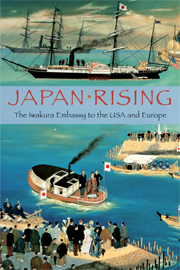Book contents
- Frontmatter
- Contents
- Introduction by Ian Nish
- Note on the Text
- VOLUME I THE UNITED STATES OF AMERICA
- VOLUME II BRITAIN
- VOLUME III CONTINENTAL EUROPE, 1
- VOLUME IV CONTINENTAL EUROPE, 2
- 61 A Survey of Russia
- 62 A Survey of Russian Railways and St. Petersburg
- 63 A Record of St. Petersburg, 1
- 64 A Record of St. Petersburg, 2
- 65 A Record of St. Petersburg, 3
- 66 A Record of Northern Germany, First Part
- 67 A Record of Denmark
- 68 A Record of Sweden, 1
- 69 A Record of Sweden, 2
- 70 A Record of Northern Germany, Second Part, 1
- 71 A Record of Northern Germany, Second Part, 2
- 72 A Record of Southern Germany
- 73 A Survey of Italy
- 74 A Record of Florence
- 75 A Record of Rome, 1
- 76 A Record of Rome, 2
- 77 A Record of Naples
- 78 A Record of Lombardy and Venice
- 79 A Survey of Austria
- 80 Travels by Rail in Austria, and a Survey of Vienna
- 81 A Record of Vienna
- VOLUME V CONTINENTAL EUROPE, 3; AND THE VOYAGE HOME
- Index
81 - A Record of Vienna
Published online by Cambridge University Press: 04 August 2010
- Frontmatter
- Contents
- Introduction by Ian Nish
- Note on the Text
- VOLUME I THE UNITED STATES OF AMERICA
- VOLUME II BRITAIN
- VOLUME III CONTINENTAL EUROPE, 1
- VOLUME IV CONTINENTAL EUROPE, 2
- 61 A Survey of Russia
- 62 A Survey of Russian Railways and St. Petersburg
- 63 A Record of St. Petersburg, 1
- 64 A Record of St. Petersburg, 2
- 65 A Record of St. Petersburg, 3
- 66 A Record of Northern Germany, First Part
- 67 A Record of Denmark
- 68 A Record of Sweden, 1
- 69 A Record of Sweden, 2
- 70 A Record of Northern Germany, Second Part, 1
- 71 A Record of Northern Germany, Second Part, 2
- 72 A Record of Southern Germany
- 73 A Survey of Italy
- 74 A Record of Florence
- 75 A Record of Rome, 1
- 76 A Record of Rome, 2
- 77 A Record of Naples
- 78 A Record of Lombardy and Venice
- 79 A Survey of Austria
- 80 Travels by Rail in Austria, and a Survey of Vienna
- 81 A Record of Vienna
- VOLUME V CONTINENTAL EUROPE, 3; AND THE VOYAGE HOME
- Index
Summary
June 7th, 1873. Cloudy; rain in the afternoon.
At nine o'clock we boarded carriages and proceeded to the Arsenal, which is located in the southern district of the city and covers a vast area. In the centre stands the Arsenal itself, a huge building with a round tower in the middle; attached to it by arches are enormous, elegant, two-storey structures extending in all four directions. Inside they are brilliantly decorated with gold-leaf and festooned with paintings showing Austrian soldiers in wars with neighbouring countries. The decor was magnificent.
Austria's military prowess has never been remarkable, and it was on account of marriage connections and inheritance that Austria was able to exercise imperial domination over the German Confederation, to absorb Holland, Belgium, Switzerland and even at one time Spain, and to exert its power over all Europe. If Charles I was able to bask in military glory, it was because he used Spanish troops. That is the reason there is merely a small amount of booty in the Arsenal. From the time of the religious wars of the sixteenth and seventeenth centuries up to the country's recent defeat of 1866, it is rather Austrian arms which have been captured by other countries and placed in quantity in their arsenals.
All countries currently manufacture cannon by casting refined iron, and they have made some wonderful discoveries. When one sees manufacturing at Woolwich in England, at the Krupp works in Germany or at the St. Petersburg works in Russia, one finds extraordinary precision, with robust pieces being produced.
- Type
- Chapter
- Information
- Japan RisingThe Iwakura Embassy to the USA and Europe, pp. 421 - 426Publisher: Cambridge University PressPrint publication year: 2009



